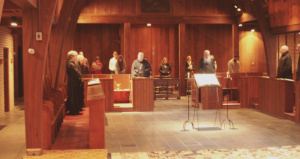“Indeed, let nothing be preferred to the Work of God.”
-Rule of St. Benedict, chapter 43
The heart of Benedictine spirituality is the Divine Office. Also called the ‘Liturgy of the Hours’ or the Opus Dei (Latin: ‘Work of God’). The Office is the daily cycle of prayer, centering on the chanting of Psalms and the reading of Scripture. The purpose of this exercise is, as monks have called it, ‘the sanctification of time.’ We frame our days and pause periodically from our work to reset our lives in the context of eternity. All of life is sacred; the Office is how we remember that.
There are many good breviaries and prayer books available to assist this process in an orderly way. Most famous among Anglicans and Episcopalians is The Book of Common Prayer. This is a fantastic resource, even for Protestants of other denominations. Presbyterians have their own version in The Book of Common Worship: Daily Prayer. Roman Catholics have the four-volume Liturgy of the Hours. The breviary I use is Benedictine Daily Prayer (abbreviated BDP), edited by Dr. Maxwell Johnson and published by Liturgical Press. What I like best about this one is its similarity to the practice of the Office at St. Gregory’s. When I pray, I like to feel connected to my brothers in the cloister, even though I can only visit the monastery once a month or so.
At St. Gregory’s, the monks say seven offices daily. They rise at 4am for Matins (also called Vigils in BDP), followed by Lauds at 6. During the day, they pause from their work every two or three hours for the “Little Hours” of Terce, Sext, and None. Vespers concludes the work day at 5pm, followed by Compline before bed. They recite the entire Psalter each week, as prescribed in the Rule of St. Benedict.
Naturally, it is difficult for someone outside the cloister to keep this kind of schedule (in point of fact, it’s not easy for monks themselves). In my own practice, I get up between 6 and 7 for a combined service of Vigils and Lauds. During the day, I try to say as many of the Little Hours as possible. Vespers is a non-negotiable. Compline is usually the last thing I do before lying down at night.
BDP uses a four-week cycle of Psalms at Vigils (with an option to do it in two weeks), a two-week cycle at Lauds, weekly at Vespers, and daily at the Little Hours and Compline. Most of the Psalter is said during this time, with perhaps a half-dozen omissions for the imprecatory (cursing) Psalms that are also omitted in the Roman Catholic Liturgy of the Hours.
My schedule requires a certain flexibility with the time at which the hours are said. Traditionally the hours were said at the “crosspoints” of the old analogue clocks (12, 3, 6, and 9; am and pm). I usually use these as a base-point and leave myself a window of an hour before or after, in which to recite that office. It ends up looking roughly thus:
6am (5-7): Vigils and Lauds (approx. 30-35 minutes)
9am (8-10): Terce (5 mins.)
12pm (11-1): Sext (5 mins.)
3pm (2-4): None (5 mins.)
6pm (5-7): Vespers (15-20 mins.)
9pm (8-10): Compline (10 mins.)
On busy days, I say a combined Vigils and Lauds, at least one of the Little Hours, Vespers, and Compline. My bare minimum is Lauds and Vespers, inserting the longer Scripture readings from Vigils. I only do this as a last resort, since it causes me to miss much of the Psalter at Vigils.
Work meetings and family commitments don’t always allow for me to say all three of the Little Hours, but I keep the goal of saying all three before my eyes. This provides a helpful framework for my day. It might seem like a lot, but each of these offices can be recited in as little as 5 minutes. If you think about it, that’s no longer than the average coffee or cigarette break at work (and without the added risk of lung cancer). The benefits are as psychological as they are spiritual. As a person who lives with ADHD, this helps me to stay on-task and organized. If I am working on a large project at work, I find that I often return to it with mind refreshed and renewed perspective. I keep an older edition of BDP in my car for this purpose, should I need to say an office on the run. The best days are when I manage to say all three.
The Divine Office is meant to be sung, rather than said. At Vigils and Lauds, I typically sing the hymn and say the rest. At the Little Hours and Compline, I sing the hymn, the Psalms, the Gospel Canticle, and the Marian Antiphon. At Vespers, I sing the entire office, except for the reading and responsory.



